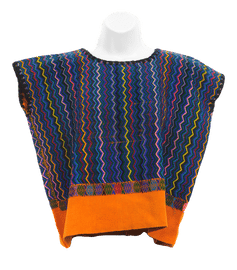Presented by Museum of the Peace Corps Experience and American University Museum
c. 1967
Weno, Chuuk Lagoon, Micronesia
Pandanus fiber, 76 1/2 x 36 1/2 in.
Collection, Museum of the Peace Corps Experience
Gift of Richard Sundt, Micronesia, Rongelap Atoll 1967–69

Guatemala is a country full of iconic postcard images, from the smoking volcanos to the colonial-era cathedrals of Antigua. The most iconic image of all is a Maya woman proudly wearing the huipil (WEE-peel)—a traditional woven blouse worn by indigenous women of Guatemala. The huipil was the most individualistic piece of a woman’s ensemble.
Weavers produced the garments on a backstrap loom as a single panel, which was then doubled over and sewn up the sides, with room for the arms. A hole was cut into the fabric for the head. In addition to the huipil, every Maya girl would wear a corte (skirt) from the time she was able to walk.
According to Maya tradition, people were taught to spin cotton into yarn and weave fabrics into textiles by the Maya moon and earth deity. The goddess is often portrayed in carvings wearing a traditional backstrap loom. Weavers wear the loom strapped around their back and waist and then fastened to a tree or similar object. Maya women consider it their sacred duty to continue the custom of weaving their own clothing as wearable art.
As time has passed, each region has customized the huipil, creating gorgeous diversity with colors and patterns. Each town and village invented its own patterns of eagles, spiders, flowers, and other natural themes, sometimes with lace or embroidered edges. When a woman wears a huipil in Guatemala City, it is obvious to all which region she comes from.
I never was able to master carrying baskets on my head or patting out tortillas, but I thought I should at least try my hand at weaving. I sat for long hours on a rush mat in the courtyard of the family compound with Doña Tomasa, one end of the loom strap circled around my back and the other attached to a tree. Chickens pecked away at my feet while children crept up behind me to touch my blond hair.
Doña Tomasa patiently guided my fingers to lift the warp to allow the threads of the weft to create a design. Eventually I produced a small weaving—certainly not enough for a huipil but enough to satisfy me (even though Doña Tomasa said my weaving looked like it might have been made by a drunken spider). I cherish this huipil that I wore while Glenn and I were Peace Corps volunteers in Guatemala.
The Committee for a Museum of the Peace Corps Experience is a 501(c)(3) private nonprofit organization. Tax ID: EIN # 93-1289853
The Museum is not affiliated with the U.S. Peace Corps and not acting on behalf of the U.S. Peace Corps.
Museum of the Peace Corps Experience © 2024. All Rights Reserved.